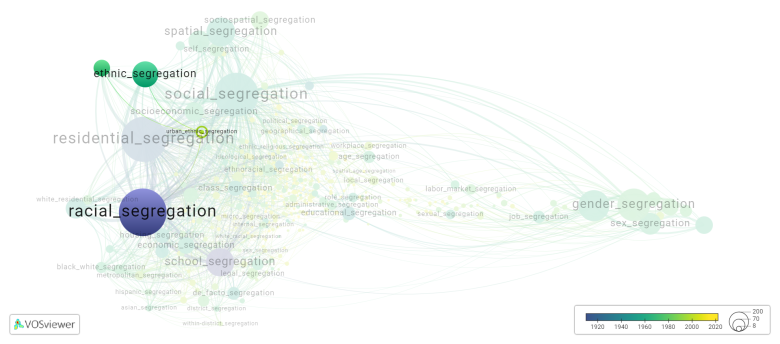Urban ethnic segregation
Date and country of first publication[1]
2005
United Kingdom
Definition
Urban ethnic segregation refers to the spatial separation of different ethnic or racial groups within a city or metropolitan area. It is often a result of historical and contemporary patterns of discrimination, socioeconomic disparities, and immigration patterns.
There are several factors that contribute to urban ethnic segregation. One factor is redlining, a discriminatory practice in which banks and government institutions denied loans or services to residents in certain neighborhoods deemed to be high-risk or predominantly non-white. This led to concentrated poverty and limited economic opportunities in these areas, contributing to segregation.
Another factor is residential preferences and self-segregation. People often choose to live in neighborhoods with others who share similar cultural or ethnic backgrounds, as they may feel more comfortable and have access to cultural amenities and social networks. Immigrant communities, for example, often settle in areas where they have a support system and can maintain cultural traditions.
Public policy also plays a role in perpetuating segregation. Zoning and housing policies can favor the construction of certain types of housing in certain areas, which can lead to the concentration of certain ethnic or racial groups in specific neighborhoods. Additionally, school district boundaries may reinforce segregation by creating separate educational experiences for different groups of students.
The consequences of urban ethnic segregation can be profound. Concentrated poverty and limited access to quality education, healthcare, and job opportunities disproportionately impact marginalized communities. Segregation can also lead to social isolation, distrust, and unequal social and political power dynamics.
Efforts to address urban ethnic segregation involve a multi-dimensional approach. Some strategies include promoting fair housing policies that reduce discrimination, investing in affordable housing in diverse neighborhoods, improving school desegregation efforts, and supporting economic development in disadvantaged areas. Community engagement and dialogue are also key to promoting understanding and integration among different ethnic and racial groups within cities.
See also
Related segregation forms
Urban ethnic segregation is frequently discussed in the literature with the following segregation forms:
ethnic segregation, ethnic residential segregation, racial segregation

This visualization is based on the study The Multidisciplinary Landscape of Segregation Research.
For the complete network of interrelated segregation forms, please refer to:
References
Notes
- ↑ Date and country of first publication as informed by the Scopus database (December 2023).
Urban ethnic segregation appears in the following literature
Boal F.W. (2005). Urban ethnic segregation and the scenarios spectrum. Desegregating The City: Ghettos, Enclaves, and Inequality, 62-78. State University of New York Press.https://doi.org/
Ireland P. (2008). Comparing responses to ethnic segregation in urban Europe. Urban Studies, 45(7), 1333-1358. https://doi.org/10.1177/0042098008090677
Kaplan D., Douzet F. (2011). Research in ethnic segregation III: Segregation outcomes. Urban Geography, 32(4), 589-605. https://doi.org/10.2747/0272-3638.32.4.589
Mojanchevska K. (2015). Swapping houses: Mobility behaviour and migration tendencies in a changing multicultural city. International Journal of Community Diversity, 15(3), 13-34. Common Ground Research Networks.https://doi.org/10.18848/2327-0004/CGP/v15i03/39967
Anderson K.J. (202). “The idea of chinatown: The power of place and institutional practice in the making of a racial category”: From annals of the association of American geographers (1987). The Urban Geography Reader, 219-228. Taylor and Francis.https://doi.org/10.4324/9780203543047-29
